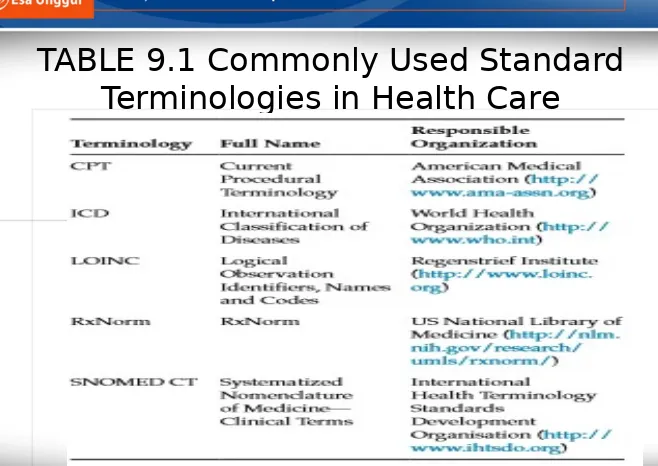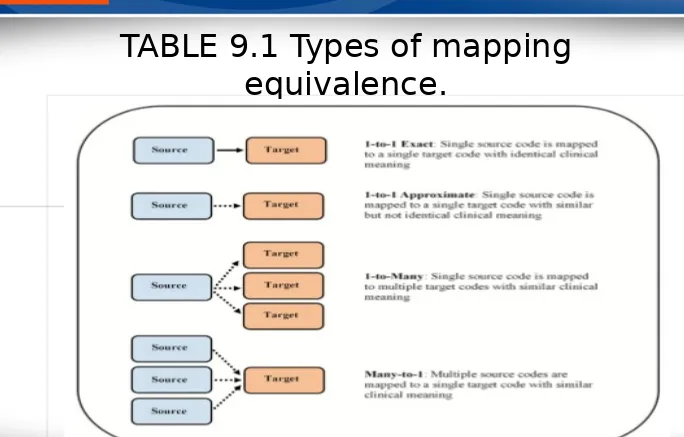Standardizing Health-Care Data Across an Enterprise PERTEMUAN Ke - 9
Taufik Rendi Anggara., MT Manajemen Informasi Kesehatan
LEARNING OBJECTIVES
•
Describe the utility of standard reference
terminologies in health information exchange.
•
Identify factors to consider when selecting
context-appropriate terminology standards.
•
Describe the process of mapping between
terminologies, as well as identify types of tools
available to assist in mapping.
•
Explain why a Terminology Service is important in
ROLE OF TERMINOLOGIES IN HEALTH
CARE
STANDARD TERMINOLOGIES IN HEALTH
CARE
SELECTION OF STANDARD TERMINOLOGIES
FOR HIE
Given there are a variety of standard terminologies, HIE leaders must determine which terminology standard(s) should be selected. The process of selecting terminology standard(s) for a given HIE service or context of use requires consideration of several factors, including:
•underlying health needs and priorities of the health system; •overall goals and objectives of the HIE or specifc HIE service; •the types or categories of data to be exchanged among a
network of systems;
•the workfow which will generate the data to be exchanged or
CURRENT USE OF STANDARD
TERMINOLOGIES
MAPPING
Cont.
EquivalenceIt should be noted that mapping does not always result in a 1-to-1 linkage from the source code to the target. Instead, many types of equivalence, or correspondence, can be observed, including:
•1-to-1 exact, where a single source code is mapped to a
single target code with identical clinical meaning;
•1-to-1 approximate, where a single source code is mapped to
a single target code with similar but not identical clinical meaning;
•1-to-many, where a single source code is mapped to multiple
target codes with similar clinical meaning;
•Many-to-1, where multiple source codes are mapped to a
Cont.
Variations and combinations of these may also occur. An illustration of the various types of mapping equivalence is presented in Fig. 9.1. At times, it may occur that a source code may not be translatable or “mapped” to a target code, resulting in an orphan code. Such an occurrence may be due to various causes, which have been elucidated by Lin and colleagues , including:
•no equivalent concept for the source code exists in the target code;
•the source code has an ambiguous meaning, and this lack of meaning precludes any linkage into a meaningful target code;
•the source code is overly specifc, preventing linkage to a less-specifc target code;
•the data are narrative “free” text with no meaning outside a specifc clinical case;
Cont.
Mapping ProcessTERMINOLOGY SERVICES
Implementation of Terminology Services
The implementation of Terminology Services within an HIE is a multistep process that begins with an assessment of available resources and the development of a project plan. To do so, the following types of activities must be addressed :
•Choosing, acquiring, installing, and confguring software and hardware.
•Populating the Terminology Service with the required dictionaries and terminologies.
•Enhancing the point-of-care systems, insurance systems, and/or national registry systems that will interact with the Terminology Services so that they can communicate with the Terminology Service through the Interoperability Layer of the architecture.
•Documenting the technical information required to support the system.
•Testing the system to ensure that it is operating as planned.
TERMINOLOGY SERVICES
Terminology Service SupportImplementation of a Terminology Service is just the beginning. Once in place, ongoing, iterative support is necessary to meet the needs of the evolving feld. Common types of support include:
•Operations support: This includes the development and maintenance of policies and procedures that are necessary to support business and technical processes for the Terminology Service. It may also comprise tasks such as evaluating adherence to the selected terminology standards.
TERMINOLOGY SERVICES
Terminology Service Support (Cont)•Help desk support: As more and more users and organizations utilize the Terminology Services, it may become important to identify, document, and triage responses to types of requests from the various users. For each request, it may be necessary to track who requested it, why it was requested, and when it was requested. Detailed information of how the issue was resolved should also be documented for reference purposes.

